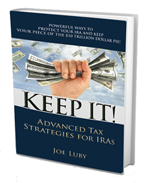Intra-family Loans in Today’s Low Interest Rate Environment
Categories: Wealth Transfer StrategiesAs Seen In The WealthCounsel Quarterly
October 2010
Article By Joe O. Luby III, CFP®
Various planning techniques are more in favor during periods of low interest rates such as we are experiencing in the US today. One of these strategies involves the use of intra-family loans to help shift wealth from one generation to the next with little or no transfer tax impact.
The current applicable federal rates (AFRs) for short-term, mid-term and long-term loans are 0.53%, 2.18% and 3.79% respectively (August 2010). In short, if the investment or asset transferred can outperform these extremely low rates, the clients win big.
Consider the following straightforward example: Mom sells a rental property to son for full fair market value of $100,000 and takes back a promissory note in that amount. The note has a twenty year term and thus uses the long-term AFR of 3.79%. The “cost” of this wealth shift to the son is the annual interest payment on the note. There is no gift tax consequence and the asset is removed from Mom’s estate for estate tax purposes. This is also known as an asset “freeze” technique because all future income and capital appreciation on the property are outside of Mom’s estate. The amount included in Mom’s estate calculation has been “frozen” at the current value of the promissory note but never more than $100,000. Assuming the net rental income and long-term capital appreciation on the property exceed the low AFR in effect, the transaction is a success.
Outperforming the AFR is a key component in these scenarios because it is the excess growth in asset values and future income post-transaction that is being shifted without transfer tax. That is why these strategies are so attractive today. It’s much easier to outperform a rate in the 2%-3% range than one in the 7%-8% range for example.
An even more powerful application of the intra-family loan strategy is the sale of discounted assets. These can be closely held business interests, partial interests in real property, fractional interests in other property or assets such as airplanes, private investments such as Jagen funds, etc.
For example, Dad owns a mid-size manufacturing concern and daughter works for said company. Dad sells a ten percent stake in the company to daughter in exchange for a promissory note at today’s long-term AFR of 3.79%. The ten percent interest in the company has a book value or net asset value of $1 million, but due to typical valuation adjustment factors such as limited liquidity, lack of marketability and lack of control (minority interest) a qualified appraisal reflects a fair market value of only $650,000 (35% adjustment). Thus the promissory note reflects $650,000 – fair market value. When the transaction is complete and the note satisfied, any value above $650,000 is essentially a tax-free gift to daughter. Dad has removed the asset and any future growth in value from his estate. The promissory note “freezes” the estate tax value of the asset at $650,000, or less depending on when Dad dies and how much principal may have been repaid on the note by then.
As with any technique, there are multiple variations on the same theme. In each of these cases the buyer could be a trust or trusts rather than the children personally. Depending on the asset sold and the relationship with the buyer, these transactions can also be a way for the senior generation to begin teaching the adult children about asset management, investing, the family business, real estate management and the competent handling of wealth. Mom and Dad can help guide son or daughter with the management of the asset purchased which can prepare them for a larger inheritance later on.
These are two simplified examples of how to use today’s low interest rate environment to motivate clients to action and produce excellent long-term results for their family. We often hear that clients are sitting on the fence until something more permanent is done on the estate tax. Bringing these techniques to the table can get clients to take action today that will be beneficial regardless of what happens to the estate tax.


Comments are closed.